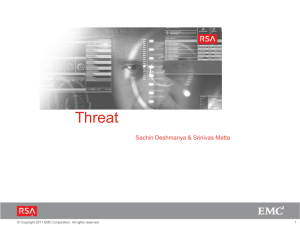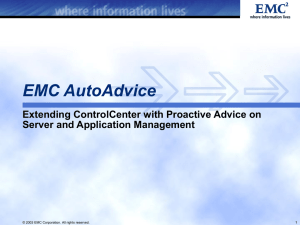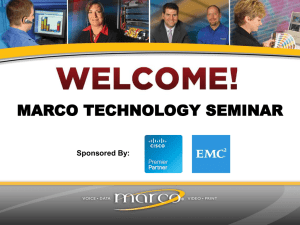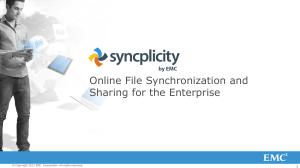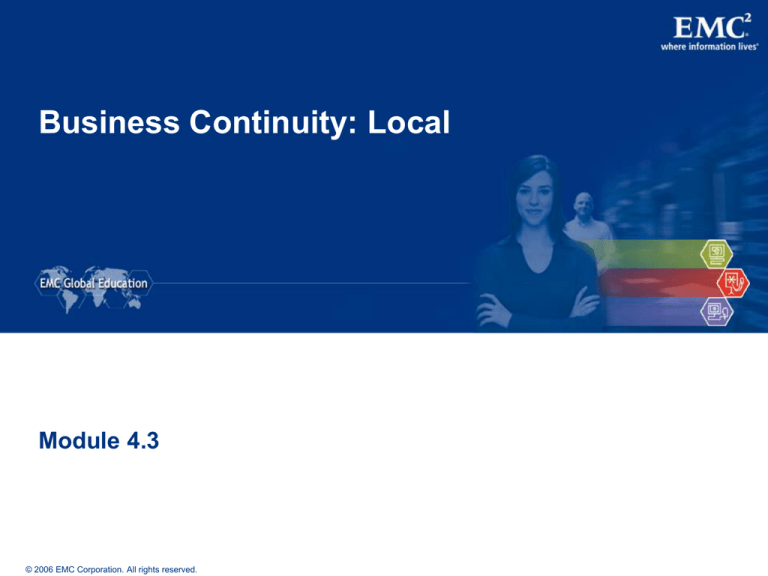
Business Continuity: Local
Module 4.3
© 2006 EMC Corporation. All rights reserved.
Local Replication
After completing this module you will be able to:
Discuss replicas and the possible uses of replicas
Explain consistency considerations when replicating file
systems and databases
Discuss host and array based replication technologies
– Functionality
– Differences
– Considerations
– Selecting the appropriate technology
© 2006 EMC Corporation. All rights reserved.
Module TitleBusiness Continuity: Local - 2
What is Replication?
Replica - An exact copy (in all details)
Replication - The process of reproducing data
REPLICATION
Original
© 2006 EMC Corporation. All rights reserved.
Replica
Module TitleBusiness Continuity: Local - 3
Possible Uses of Replicas
Alternate source for backup
Source for fast recovery
Decision support
Testing platform
Migration
© 2006 EMC Corporation. All rights reserved.
Module TitleBusiness Continuity: Local - 4
Considerations
What makes a replica good?
– Recoverability
Considerations for resuming operations with primary
– Consistency/re-startability
How is this achieved by various technologies
Kinds of Replicas
– Point-in-Time (PIT) = finite RPO
– Continuous = zero RPO
How does the choice of replication technology tie back
into RPO/RTO?
© 2006 EMC Corporation. All rights reserved.
Module TitleBusiness Continuity: Local - 5
Replication of File Systems
Host
Apps
Operating System
Mgmt Utilities
DBMS
File System
Buffer
Volume Management
Multi-pathing Software
Device Drivers
HBA
HBA
HBA
Physical Volume
© 2006 EMC Corporation. All rights reserved.
Module TitleBusiness Continuity: Local - 6
Replication of Database Applications
A database application may be spread out over numerous
files, file systems, and devices—all of which must be
replicated.
Database replication can be offline or online.
Data
© 2006 EMC Corporation. All rights reserved.
Logs
Module TitleBusiness Continuity: Local - 7
Database: Understanding Consistency
Databases/Applications maintain integrity by following the
“Dependent Write I/O Principle”
– Dependent Write: A write I/O that will not be issued by an application
until a prior related write I/O has completed
A logical dependency, not a time dependency
– Inherent in all Database Management Systems (DBMS)
e.g. Page (data) write is dependent write I/O based on a successful log
write
– Applications can also use this technology
– Necessary for protection against local outages
Power failures create a dependent write consistent image
A Restart transforms the dependent write consistent to transactionally
consistent
i.e. Committed transactions will be recovered, in-flight transactions will be
discarded
© 2006 EMC Corporation. All rights reserved.
Module TitleBusiness Continuity: Local - 8
Database Replication: Transactions
Buffer
Database
Application
1
1
2
2
3
3
4
4
Data
Log
© 2006 EMC Corporation. All rights reserved.
Module TitleBusiness Continuity: Local - 9
Database Replication: Consistency
Source
Data
Replica
1
1
2
2
3
3
4
4
Log
Data
Log
Consistent
Note: In this example, the database is online.
© 2006 EMC Corporation. All rights reserved.
Module TitleBusiness Continuity: Local - 10
Database Replication: Consistency
Source
Replica
1
Data
2
3
3
4
4
Log
Inconsistent
Note: In this example, the database is online.
© 2006 EMC Corporation. All rights reserved.
Module TitleBusiness Continuity: Local - 11
Database Replication: Ensuring Consistency
Off-line Replication
– If the database is offline or
shutdown and then a replica is
created, the replica will be
consistent.
Source
Replica
– In many cases, creating an offline
replica may not be a viable due to
the 24x7 nature of business.
Data
Database
Application
(Offline)
Log
Consistent
© 2006 EMC Corporation. All rights reserved.
Module TitleBusiness Continuity: Local - 12
Database Replication: Ensuring Consistency
Online Replication
– Some database applications allow
replication while the application is up
and running
– The production database would have to
be put in a state which would allow it to
be replicated while it is active
– Some level of recovery must be
performed on the replica to make the
replica consistent
Source
Replica
1
Data
2
3
3
4
4
Log
Inconsistent
© 2006 EMC Corporation. All rights reserved.
Module TitleBusiness Continuity: Local - 13
Database Replication: Ensuring Consistency
Source
5
5
Replica
1
1
2
2
3
3
4
4
Consistent
© 2006 EMC Corporation. All rights reserved.
Module TitleBusiness Continuity: Local - 14
Tracking Changes After PIT Creation
At PIT
Later
Resynch
Source = Target
Source ≠ Target
Source = Target
© 2006 EMC Corporation. All rights reserved.
Module TitleBusiness Continuity: Local - 15
Local Replication Technologies
Host based
– Logical Volume Manager (LVM) based mirroring
– File System Snapshots
Storage Array based
– Full volume mirroring
– Full volume: Copy on First Access
– Pointer based: Copy on First Write
© 2006 EMC Corporation. All rights reserved.
Module TitleBusiness Continuity: Local - 16
Logical Volume Manager: Review
Host resident software responsible for
creating and controlling host level logical
storage
– Physical view of storage is converted to a
logical view by mapping. Logical data
blocks are mapped to physical data blocks.
– Logical layer resides between the physical
layer (physical devices and device drivers)
and the application layer (OS and
applications see logical view of storage).
Logical Storage
LVM
Usually offered as part of the operating
system or as third party host software
LVM Components:
– Physical Volumes
– Volume Groups
– Logical Volumes
© 2006 EMC Corporation. All rights reserved.
Physical Storage
Module TitleBusiness Continuity: Local - 17
Volume Groups
One or more Physical Volumes
form a Volume Group
LVM manages Volume Groups
as a single entity
Physical Volumes can be added
and removed from a Volume
Group as necessary
Physical Volumes are typically
divided into contiguous equalsized disk blocks
Physical
Volume 1
Physical
Volume 2
Physical
Volume 3
Volume Group
Physical
Disk
Block
A host will always have at least
one disk group for the Operating
System
– Application and Operating
System data maintained in
separate volume groups
© 2006 EMC Corporation. All rights reserved.
Module TitleBusiness Continuity: Local - 18
Logical Volumes
Logical Volume
Logical Volume
Physical Volume 1
Physical Volume 2
Volume Group
© 2006 EMC Corporation. All rights reserved.
Logical Disk
Block
Physical Volume 3
Physical Disk
Block
Module TitleBusiness Continuity: Local - 19
Host Based Replication: Mirrored Logical Volumes
PVID1
Host
Logical Volume
VGDA
Physical
Volume 1
VGDA
Physical
Volume 2
Logical Volume
PVID2
© 2006 EMC Corporation. All rights reserved.
Module TitleBusiness Continuity: Local - 20
Host Based Replication: File System Snapshots
Many LVM vendors will allow the creation of File System
Snapshots while a File System is mounted
File System snapshots are typically easier to manage
than creating mirrored logical volumes and then splitting
them
© 2006 EMC Corporation. All rights reserved.
Module TitleBusiness Continuity: Local - 21
Host (LVM) Based Replicas: Disadvantages
LVM based replicas add overhead on host CPUs
If host devices are already Storage Array devices then
the added redundancy provided by LVM mirroring is
unnecessary
– The devices will have some RAID protection already
Host based replicas can be usually presented back to the
same server
Keeping track of changes after the replica has been
created
© 2006 EMC Corporation. All rights reserved.
Module TitleBusiness Continuity: Local - 22
Storage Array Based Local Replication
Replication performed by the Array Operating
Environment
Replicas are on the same array
Array
Source
Production
Server
© 2006 EMC Corporation. All rights reserved.
Replica
Business
Continuity Server
Module TitleBusiness Continuity: Local - 23
Storage Array Based – Local Replication Example
Typically Array based replication is done at a array device
level
– Need to map storage components used by an application/file system
back to the specific array devices used – then replicate those
devices on the array
Array 1
Logical Volume 1
c12t1d1
c12t1d2
File System 1
Source
Vol 1
Replica
Vol 1
Source
Vol 2
Replica
Vol 2
Volume Group 1
© 2006 EMC Corporation. All rights reserved.
Module TitleBusiness Continuity: Local - 24
Array Based Local Replication: Full Volume Mirror
Attached
Read/Write
Not Ready
Target
Source
Array
© 2006 EMC Corporation. All rights reserved.
Module TitleBusiness Continuity: Local - 25
Array Based Local Replication: Full Volume Mirror
Detached - PIT
Read/Write
Read/Write
Target
Source
Array
© 2006 EMC Corporation. All rights reserved.
Module TitleBusiness Continuity: Local - 26
Array Based Local Replication: Full Volume Mirror
For future re-synchronization to be incremental, most
vendors have the ability to track changes at some level of
granularity (e.g., 512 byte block, 32 KB, etc.)
– Tracking is typically done with some kind of bitmap
Target device must be at least as large as the Source
device
– For full volume copies the minimum amount of storage required is
the same as the size of the source
© 2006 EMC Corporation. All rights reserved.
Module TitleBusiness Continuity: Local - 27
Copy on First Access (COFA)
Target device is made accessible for BC tasks as soon as
the replication session is started.
Point-in-Time is determined by time of activation
Can be used in Copy First Access mode (deferred) or in
Full Copy mode
Target device is at least as large as the Source device
© 2006 EMC Corporation. All rights reserved.
Module TitleBusiness Continuity: Local - 28
Copy on First Access Mode: Deferred Mode
Write to Source
Read/Write
Read/Write
Target
Source
Write to Target
Read/Write
Read/Write
Source
Target
Read from Target
Read/Write
Read/Write
Source
© 2006 EMC Corporation. All rights reserved.
Target
Module TitleBusiness Continuity: Local - 29
Copy on First Access: Full Copy Mode
On session start, the entire contents of the Source device
is copied to the Target device in the background
Most vendor implementations provide the ability to track
changes:
– Made to the Source or Target
– Enables incremental re-synchronization
© 2006 EMC Corporation. All rights reserved.
Module TitleBusiness Continuity: Local - 30
Array: Pointer Based Copy on First Write
Targets do not hold actual data, but hold pointers to
where the data is located
– Actual storage requirement for the replicas is usually a small fraction
of the size of the source volumes
A replication session is setup between the Source and
Target devices and started
– When the session is setup based on the specific vendors
implementation a protection map is created for all the data on the
Source device at some level of granularity (e.g 512 byte block, 32
KB etc.)
– Target devices are accessible immediately when the session is
started
– At the start of the session the Target device holds pointers to the
data on the Source device
© 2006 EMC Corporation. All rights reserved.
Module TitleBusiness Continuity: Local - 31
Pointer Based Copy on First Write Example
Target
Virtual Device
Source
© 2006 EMC Corporation. All rights reserved.
Save Location
Module TitleBusiness Continuity: Local - 32
Array Replicas: Tracking Changes
Changes will/can occur to the Source/Target devices after
PIT has been created
How and at what level of granularity should this be
tracked?
– Too expensive to track changes at a bit by bit level
Would require an equivalent amount of storage to keep track of which bit
changed for each the source and the target
– Based on the vendor some level of granularity is chosen and a bit
map is created (one for Source and one for Target)
One could choose 32 Kb as the granularity
For a 1 GB device changes would be tracked for 32768 32Kb chunks
If any change is made to any bit on one 32Kb chunk the whole chunk is
flagged as changed in the bit map
1 GB device map would only take up 32768/8/1024 = 4Kb space
© 2006 EMC Corporation. All rights reserved.
Module TitleBusiness Continuity: Local - 33
Array Replicas: How Changes Are Determined
Source
0
0
0
0
0
0
0
0
Target
0
0
0
0
0
0
0
0
Source
1
0
0
1
0
1
0
0
Target
0
0
1
1
0
0
0
1
1
0
1
1
0
1
0
1
At PIT
After PIT…
Resynch
0
© 2006 EMC Corporation. All rights reserved.
= unchanged
1
= changed
Module TitleBusiness Continuity: Local - 34
Array Replication: Multiple PITs
Target Devices
06:00 A.M.
Source
12:00 P.M.
Point-In-Time
06:00 P.M.
12:00 A.M.
: 12 : 01 : 02 : 03 : 04 : 05 : 06 : 07 : 08 : 09 : 10 : 11 : 12 : 01 : 02 : 03 : 04 : 05 : 06 : 07 : 08 : 09 : 10 : 11 :
A.M.
© 2006 EMC Corporation. All rights reserved.
P.M.
Module TitleBusiness Continuity: Local - 35
Array Replicas: Ensuring Consistency
Source
C
Replica
Source
Replica
1
1
1
2
2
2
3
3
3
3
4
4
4
4
Consistent
© 2006 EMC Corporation. All rights reserved.
D
Inconsistent
Module TitleBusiness Continuity: Local - 36
Mechanisms to Hold IO
Host based
Array based
What if the application straddles multiple hosts and
multiple arrays?
© 2006 EMC Corporation. All rights reserved.
Module TitleBusiness Continuity: Local - 37
Array Replicas: Restore/Restart Considerations
Production has a failure
– Logical Corruption
– Physical failure of production devices
– Failure of Production server
Solution
– Restore data from replica to production
The restore would typically be done in an incremental manner and the
Applications would be restarted even before the synchronization is
complete leading to very small RTO
-----OR------
– Start production on replica
Resolve issues with production while continuing operations on replicas
After issue resolution restore latest data on replica to production
© 2006 EMC Corporation. All rights reserved.
Module TitleBusiness Continuity: Local - 38
Array Replicas: Restore/Restart Considerations
Before a Restore
– Stop all access to the Production devices and the Replica devices
– Identify Replica to be used for restore
Based on RPO and Data Consistency
– Perform Restore
Before starting production on Replica
– Stop all access to the Production devices and the Replica devices
– Identify Replica to be used for restart
Based on RPO and Data Consistency
– Create a “Gold” copy of Replica
As a precaution against further failures
– Start production on Replica
RTO drives choice of replication technology
© 2006 EMC Corporation. All rights reserved.
Module TitleBusiness Continuity: Local - 39
Array Replicas: Restore Considerations
Full Volume Replicas
– Restores can be performed to either the original source device or to
any other device of like size
Restores to the original source could be incremental in nature
Restore to a new device would involve a full synchronization
Pointer Based Replicas
– Restores can be performed to the original source or to any other
device of like size as long as the original source device is healthy
Target only has pointers
Pointers to source for data that has not been written to after PIT
Pointers to the “save” location for data was written after PIT
Thus to perform a restore to an alternate volume the source must be
healthy to access data that has not yet been copied over to the target
© 2006 EMC Corporation. All rights reserved.
Module TitleBusiness Continuity: Local - 40
Array Replicas: Which Technology?
Full Volume Replica
– Replica is a full physical copy of the source device
– Storage requirement is identical to the source device
– Restore does not require a healthy source device
– Activity on replica will have no performance impact on the source
device
– Good for full backup, decision support, development, testing and
restore to last PIT
– RPO depends on when the last PIT was created
– RTO is extremely small
© 2006 EMC Corporation. All rights reserved.
Module TitleBusiness Continuity: Local - 41
Array Replicas: Which Technology? …
Pointer based - COFW
– Replica contains pointers to data
Storage requirement is a fraction of the source device (lower cost)
– Restore requires a healthy source device
– Activity on replica will have some performance impact on source
Any first write to the source or target will require data to be copied to the
save location and move pointer to save location
Any read IO to data not in the save location will have to be serviced by
the source device
– Typically recommended if the changes to the source are less than
30%
– RPO depends on when the last PIT was created
– RTO is extremely small
© 2006 EMC Corporation. All rights reserved.
Module TitleBusiness Continuity: Local - 42
Array Replicas: Which Technology?
Full Volume – COFA Replicas
– Replica only has data that was accessed
– Restore requires a healthy source device
– Activity on replica will have some performance impact
Any first access on target will require data to be copied to target before
the I/O to/from target can be satisfied
– Typically replicas created with COFA only are not as useful as
replicas created with the full copy mode – Recommendation would
be to use the full copy mode it the technology allows such an option
© 2006 EMC Corporation. All rights reserved.
Module TitleBusiness Continuity: Local - 43
Array Replicas: Full Volume vs. Pointer Based
Full Volume
Pointer Based
Required Storage
100% of Source
Fraction of Source
Performance Impact
None
Some
RTO
Very small
Very small
Restore
Source need not be
healthy
Requires a healthy
source device
Data change
No limits
< 30%
© 2006 EMC Corporation. All rights reserved.
Module TitleBusiness Continuity: Local - 44
Module Summary
Key points covered in this module:
Replicas and the possible use of Replicas
Consistency considerations when replicating File
Systems and Databases
Host and Array based Replication Technologies
– Advantages/Disadvantages
– Differences
– Considerations
– Selecting the appropriate technology
© 2006 EMC Corporation. All rights reserved.
Module TitleBusiness Continuity: Local - 45
Check Your Knowledge
What is a replica?
What are the possible uses of a replica?
What is consistency in the context of a database?
How can consistency be ensured when replicating a
database?
Discuss one host based replication technology
What is the difference between full volume mirrors and
pointer based replicas?
What are the considerations when performing restore
operations for each replication technology?
© 2006 EMC Corporation. All rights reserved.
Module TitleBusiness Continuity: Local - 46
Apply Your Knowledge…
Upon completion of this topic, you will be able to:
List EMC’s Local Replication Solutions for the
Symmetrix and CLARiiON arrays
Describe EMC’s TimeFinder/Mirror Replication Solution
Describe EMC’s SnapView - Snapshot Replication
Solution
© 2006 EMC Corporation. All rights reserved.
Module TitleBusiness Continuity: Local - 47
EMC – Local Replication Solutions
EMC Symmetrix Arrays
– EMC TimeFinder/Mirror
Full volume mirroring
– EMC TimeFinder/Clone
Full volume replication
– EMC TimeFinder/SNAP
Pointer based replication
EMC CLARiiON Arrays
– EMC SnapView Clone
Full volume replication
– EMC SnapView Snapshot
Pointer based replication
© 2006 EMC Corporation. All rights reserved.
Module TitleBusiness Continuity: Local - 48
EMC TimeFinder/Mirror - Introduction
Array based local replication technology for Full Volume Mirroring on EMC
Symmetrix Storage Arrays
– Create Full Volume Mirrors of an EMC Symmetrix device within an Array
TimeFinder/Mirror uses special Symmetrix devices called Business
Continuance Volumes (BCV). BCVs:
– Are devices dedicated for Local Replication
– Can be dynamically, non-disruptively established with a Standard device. They
can be subsequently split instantly to create a PIT copy of data.
The PIT copy of data can be used in a number of ways:
– Instant restore – Use BCVs as standby data for recovery
– Decision Support operations
– Backup – Reduce application downtime to a minimum (offline backup)
– Testing
TimeFinder/Mirror is available in both Open Systems and Mainframe
environments
© 2006 EMC Corporation. All rights reserved.
Module TitleBusiness Continuity: Local - 49
EMC TimeFinder/Mirror – Operations
Establish
– Synchronize the Standard volume to the BCV
volume
– BCV is set to a Not Ready state when
established
BCV cannot be independently addressed
– Re-synchronization is incremental
– BCVs cannot be established to other BCVs
– Establish operation is non-disruptive to the
Standard device
STD
BCV
Establish
Incremental Establish
– Operations to the Standard can proceed as
normal during the establish
© 2006 EMC Corporation. All rights reserved.
Module TitleBusiness Continuity: Local - 50
EMC TimeFinder/Mirror – Operations …
Split
– Time of Split is the Point-in-Time
– BCV is made accessible for BC Operations
– Consistency
Consistent Split
– Changes tracked
STD
BCV
Split
© 2006 EMC Corporation. All rights reserved.
Module TitleBusiness Continuity: Local - 51
EMC TimeFinder/Mirror Consistent Split
EMC PowerPath
Enginuity Consistency Assist
Host
STD
BCV
PowerPath is an EMC host based multi-
pathing software
PowerPath holds I/O during
TimeFinder/Mirror Split
-Read and write I/O
© 2006 EMC Corporation. All rights reserved.
STD
BCV
Symmetrix Microcode holds I/O during
TimeFinder/Mirror Split
- Write I/O (subsequent reads after first
write)
Module TitleBusiness Continuity: Local - 52
EMC TimeFinder/Mirror – Operations …
Restore
– Synchronize contents of BCV volume to the
Standard volume
– Restore can be full or incremental
STD
– BCV is set to a Not Ready state
– I/Os to the Standard and BCVs should be
stopped before the restore is initiated
BCV
Incremental Restore
Query
– Provide current status of BCV/Standard volume
pairs
© 2006 EMC Corporation. All rights reserved.
Module TitleBusiness Continuity: Local - 53
EMC TimeFinder/Mirror Multi-BCVs
Standard device keeps track of changes to multiple BCVs
one after the other
Incremental establish or restore
Incremental establish
BCV
2:00 a.m.
Establish
Standard
volume
Split
Standard
volume
BCV
4:00 a.m.
or
BCV
4:00 a.m.
Establish
Incremental restore
Split
BCV
© 2006 EMC Corporation. All rights reserved.
6:00 a.m.
Module TitleBusiness Continuity: Local - 54
TimeFinder/Mirror Concurrent BCVs
Two BCVs can be established
concurrently with the same
Standard device
Establish BCVs simultaneously or
one after the other
BCVs can be split individually or
simultaneously.
Simultaneous. “Concurrent
Restores”, are not allowed
© 2006 EMC Corporation. All rights reserved.
BCV1
Standard
BCV2
Module TitleBusiness Continuity: Local - 55
EMC CLARiiON SnapView - Snapshots
SnapView allows full copies and pointer-based copies
– Full copies – Clones (sometimes called BCVs)
– Pointer-based copies – Snapshots
Because they are pointer-based, Snapshots
– Use less space than a full copy
– Require a ‘save area’ to be provisioned
– May impact the performance of the LUN they are associated with
The ‘save area’ is called the ‘Reserved LUN Pool’
The Reserved LUN Pool
– Consists of private LUNs (LUNs not visible to a host)
– Must be provisioned before Snapshots can be made
© 2006 EMC Corporation. All rights reserved.
Module TitleBusiness Continuity: Local - 56
The Reserved LUN Pool
Reserved LUN
Pool
FLARE LUN 5
Private LUN 5
FLARE LUN 6
Private LUN 6
FLARE LUN 7
Private LUN 7
FLARE LUN 8
Private LUN 8
© 2006 EMC Corporation. All rights reserved.
Module TitleBusiness Continuity: Local - 57
Reserved LUN Allocation
Reserved LUN
Pool
Source LUNs
Snapshot 1a
Session 1a
Private LUN 5
LUN 1
Snapshot 1b
Session 1b
Private LUN 6
Private LUN 7
Private LUN 8
LUN 2
Snapshot 2a
© 2006 EMC Corporation. All rights reserved.
Session 2a
Module TitleBusiness Continuity: Local - 58
SnapView Terms
Snapshot
– The ‘virtual LUN’ seen by a secondary host
– Made up of data on the Source LUN and data in the RLP
– Visible to the host (online) if associated with a Session
Session
– The mechanism that tracks the changes
– Maintains the pointers and the map
– Represents the point in time
Activate and deactivate a Snapshot
– Associate and disassociate a Session with a Snapshot
Roll back
– Copy data from a (typically earlier) Session to the Source LUN
© 2006 EMC Corporation. All rights reserved.
Module TitleBusiness Continuity: Local - 59
COFW and Reads from Snapshot
Chunk
0’
0
Chunk
1
Chunk
2
Chunk
3’’
3’
3
Primary Host
Source LUN
Secondary
Host
SnapView
Map
Chunk
4
Snapshot
Chunk
3
Chunk
0
Reserved LUN
© 2006 EMC Corporation. All rights reserved.
Map
SP memory
Module TitleBusiness Continuity: Local - 60
Writes to Snapshot
Chunk
0’
Chunk
1
Chunk
2
Chunk
3’’
Source LUN
Primary Host
Snapshot
Secondary
Host
SnapView
Map
Chunk
4
Chunk
3
Chunk
0*
0
Chunk
0
Chunk
2*
2
Reserved LUN
© 2006 EMC Corporation. All rights reserved.
Map
Chunk
2
SP memory
Module TitleBusiness Continuity: Local - 61
Rollback - Snapshot Active (preserve changes)
Chunk
0*
0’
Chunk
1
Chunk
2*
2
Chunk
3’’
3
Chunk
4
Source LUN
Primary Host
Secondary
Host
SnapView
Map
Snapshot
Chunk
3
Chunk
0*
Chunk
0
Chunk
2*
Reserved LUN
© 2006 EMC Corporation. All rights reserved.
Map
Chunk
2
SP memory
Module TitleBusiness Continuity: Local - 62
Rollback - Snapshot Deactivated (discard changes)
Chunk
0’
0
Chunk
1
Chunk
2
Chunk
3’’
3
Chunk
4
Source LUN
Primary Host
Secondary
Host
SnapView
Map
Snapshot
Chunk
3
Chunk
0*
Chunk
0
Chunk
2*
Reserved LUN
© 2006 EMC Corporation. All rights reserved.
Map
Chunk
2
SP memory
Module TitleBusiness Continuity: Local - 63

